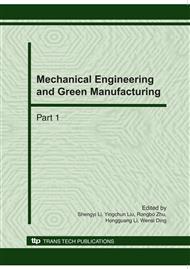p.1124
p.1129
p.1135
p.1140
p.1145
p.1149
p.1154
p.1159
p.1165
Surface Texture’s Role in Assessing Surface Integrity of Machined Parts
Abstract:
Surface texture, as one of the typical surface integrity characteristics, plays a vital part in efficiently and systematically evaluating the surface integrity and relevant mechanical properties of machined parts. Commonly used 2D surface roughness parameters are formularized and discussed in this paper. And 3D characterization technique is also illustrated through measuring and describing a machined surface with an optical profiling system. The relationship between surface texture and the fatigue property of final machined parts are discussed by employing the quantity of effective stress concentration factor which could be expressed by the standard surface roughness parameters and measured averaged root radius of surface texture’s valleys. This research emphasizes the indispensable role of the surface texture in evaluating surface integrity and corresponding functional performance of machined parts.
Info:
Periodical:
Pages:
1145-1148
Citation:
Online since:
October 2010
Authors:
Price:
Сopyright:
© 2010 Trans Tech Publications Ltd. All Rights Reserved
Share:
Citation:


